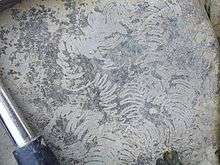Nereites
| Nereites | |
|---|---|
 | |
| Nereites irregularis | |
| Trace fossil classification | |
| Ichnogenus: | Nereites |
| Ichnospecies: | Nereites irregularis |
Nereites irregularis (formerly Helminthoida labyrinthica and Helminthoida crassa) is a type of trace fossil found on sedimentary rocks.[1][2] They are relatively small Nereites characterized by large numbers of closely packed deeply meandering trails that tend to coil.[3][4] The trails are usually horizontal and may be regular to irregular in guidance. The central tunnel is usually thicker than the envelope zone. In dense meanders, the envelope zone may touch or overlap, but it displays low-amplitude lobes in looser meanders.[3]
Nereites irregularis has not been matched with known modern organisms, but they are generally believed to have been grazing trails (pascichnia) made by worms.[5]
References
- ↑ Alfred Uchmann (2004). "Phanerozoic history of deep-sea trace fossils". In D. McIlroy. The Application of Ichnology to Palaeoenvironmental and Stratigraphic Analysis. Geological Society Special Publications. 228. Geological Society of London. pp. 125–140. ISBN 9781862391543.
- ↑ María I. López Cabrera; Eduardo B. Olivero; Noelia B. Carmona; Juan J. Ponce (2008). "Cenozoic trace fossils of the Cruziana, Zoophycos and Nereites ichnofacies from the Fuegian Andes, Argentina". Ameghiniana. 45 (2).
- 1 2 Andreas Wetzel & Alfred Uchman (1997). "Ichnology of deep-sea fan overbank deposits of the Ganei Slates (Eocene, Switzerland)– a classical flysch trace fossil locality studied first by Oswald Heer". Ichnos. 5: 139&ndash, 162. doi:10.1080/10420949709386413.
- ↑ Noelia B. Carmona; Luis A. Buatois; María Gabriela Mángano; Richard G. Bromley (2008). "Ichnology of the Lower Miocene Chenque Formation, Patagonia, Argentina: animal - substrate interactions and the Modern Evolutionary Fauna". Ameghiniana. 45 (1).
- ↑ Luigi M. Bianchi (2003–2005). "Of Worms, Fossilized Scribbles, and Science". York University. Retrieved October 30, 2013.
This article is issued from
Wikipedia.
The text is licensed under Creative Commons - Attribution - Sharealike.
Additional terms may apply for the media files.